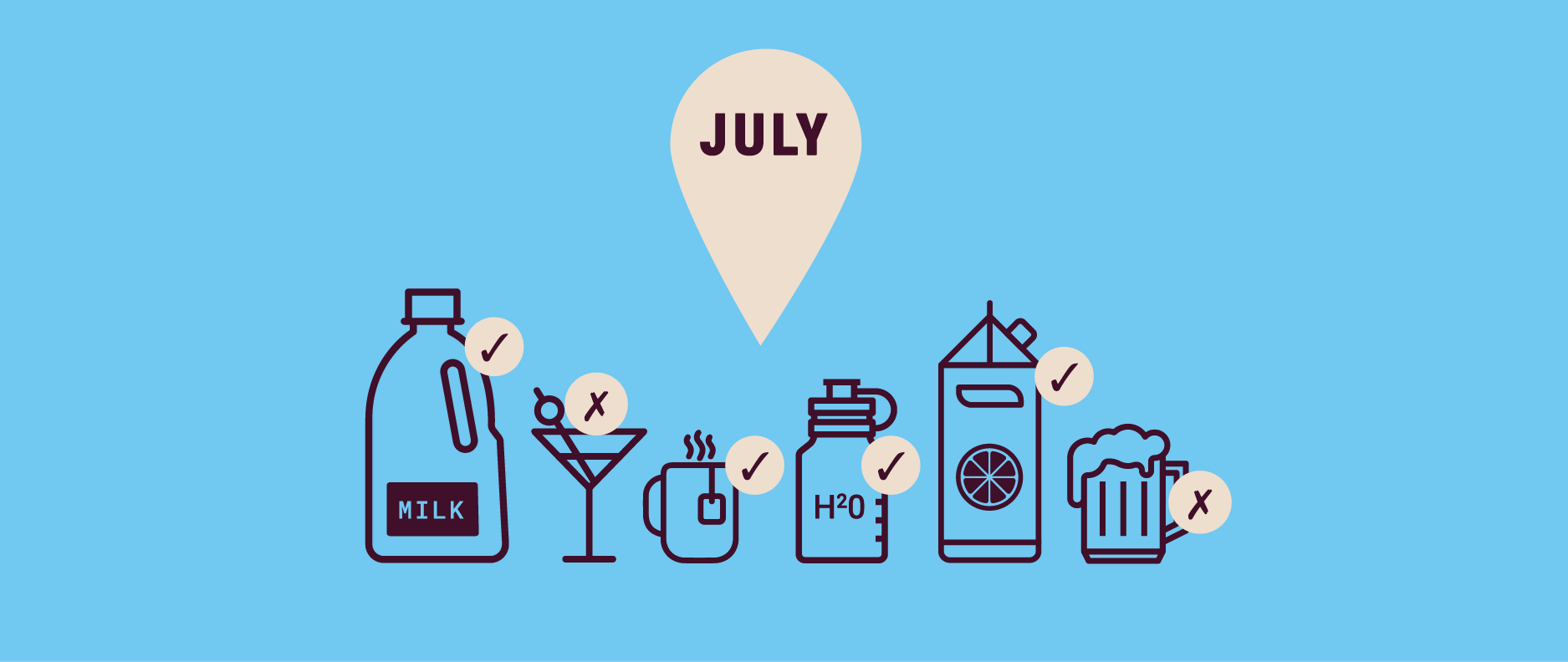
Dry July
Over the last month many of us have been participating in Dry July and challenging ourselves to go alcohol free. With the month coming to an end it may be a good time to consider how, and if, you’re going to return to drinking alcohol.
Should I be thinking about cutting down?
The Australian National Health and Medical Research Council guidelines states that “To reduce the risk of harm from alcohol-related disease or injury, healthy men and women should drink no more than 10 standard drinks a week and no more than four standard drinks on any one day.”
If you are unsure about whether your current drinking pattern is placing you at risk you can complete the Alcohol Use Disorders Identification Test (AUDIT).
What is a standard drink?
In Australia a standard drink contains 10 grams of pure alcohol. This looks a little different for each drink depending on what the ingredients are. For example, a 375ml tinny with an alcohol percentage of 4.2% contains 1.2 standard drinks, while a pint of full-strength beer (4.8%) contains 1.79 standard drinks. In Australia most alcohol packing will state the alcohol percentage and standard drinks, but if it doesn’t you can head to Drinkwise standard drinks calculator to do the maths for you!
What if I’m not sure about continuing cutting down?
Firstly, if you’re in two minds about cutting down on your alcohol consumption, it may be worth taking some time to consider the benefits and costs of cutting down vs. staying the same.
For example, some benefits of cutting down include:
- Improving your health. Health problems such as liver disease, cancer and heart problems are strongly linked to drinking alcohol.
- Consuming fewer calories of no nutritional value
- Improving sleep. While alcohol may help you to fall asleep, alcohol can increase number of night time awakenings, waking earlier in the morning, and poorer quality sleep overall.
- Improving mood. While it may be tempting to have a couple of drinks to improve your mood or take the edge off after a long day at work, in the long run alcohol can make anxiety, depression, stress and other mental health conditions worse.
And some costs of cutting down include:
- You might think events will be more boring
- Friends/family may question your choice
- It’s hard to change
What can I do to cut down?
If you choose to continue cutting down make a plan and consider the following:
- How many days each week do you want to drink? And what days will be your alcohol-free days?
- How many drinks would you like to have each day?
- What is the highest number of drinks you want to have at any one time?
- What strategies will I use to stick to this plan?
Some strategies for cutting down could include:
- Decide how much you will be drinking before you start and count your drinks.
- Don’t allow others to top up your glass and avoid topping up half empty glasses as this can make it hard to keep track of how many standard drinks you have had.
- Alternate between alcoholic and non-alcoholic drinks.
- Choose beverages with a lower alcohol content.
- Rehearse how you will say no if someone offers you a drink and you have reached your limit (“I’m pacing myself, I’ll have a soda water thanks”) or are not planning on drinking (“It’s my alcohol-free day”).
- Drink at the pace of someone else who drinks less than you.
- Do something else while drinking such as eating a meal, playing a board game, or rounds of pool.
Plan for high risk situations
High-risk situations are those where you drink more than you mean to or experience strong cravings to drink that are hard to resist. They can include:
- Specific places, times or people (e.g., at the pub on chase the ace night with mates).
- Experiencing certain emotions like being anxious, stressed or irritable, or moods like being depressed (e.g., drinking after you’ve had a row with your partner or a family member).
For high risk situations, problem solve possible solutions (e.g., drive to the pub) and other ways of coping (e.g., speak to a friend; go to the gym; meditate), select the most promising solution(s), and evaluate how you went next time you’re faced with that high-risk situation.
Use this problem-solving worksheet to help you identify if there is an problem and to brainstorm some possible solutions.
Written by Dr Gemma Healey, Clinical Psychology Registrar
More information
If you’re concerned about your drinking, would like to learn more about cutting down or want to book an appointment with Dr Gemma Healey or another one of our experienced clinical psychologists, contact our friendly client team by calling 6143 4499 or email via our contact page.

Contact
Ph: (08) 6143 4499
Fax: (08) 9200 5696
Monday to Thurs 8:30am - 7:30pm
Friday 8:30am - 4:30pm
Saturday 8:30am - 2:30pm
Locations
6 Outram Street
West Perth, 6005 WA
36 St Quentin Avenue
Claremont, 6010 WA
In the spirit of reconciliation, Lawson Clinical Psychology acknowledges the Traditional Custodians of country throughout Australia and their connections to land, sea and community. We pay our respect to their Elders past and present and extend that respect to all Aboriginal and Torres Strait Islander peoples today.
Lawson Clinical Psychology celebrates the extraordinary diversity of people’s bodies, ability, genders, sexualities and relationships that they represent.
Copyright © 2024 Lawson Clinical Psychology. All Rights Reserved. Privacy Policy.
